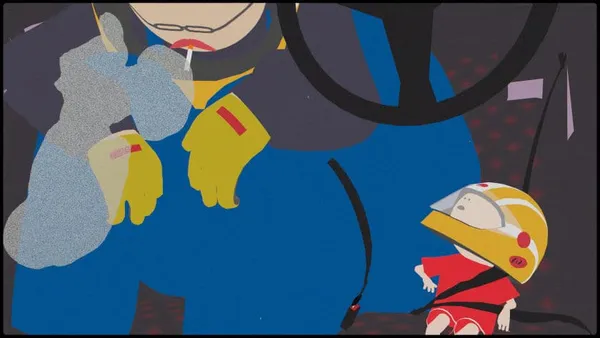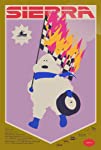Eye For Film >> Movies >> Sierra (2021) Film Review
Sierra
Reviewed by: Andrew Robertson

In the plant pot the child sways, the steady stream from the hose sends them back and forth as if the bale guardian of a used car lot. A directionless winding, more vesper than Vespa. Drawn towards them the frog emits static like a submarine's toad array. The greenhouse, the garage. The older she, the older he. The frogs.
Always the frogs. Or, rather, the sensibility of their design. Something stylised, paper deep. An accuracy to it all in shape and stature. There's a car, a red one, probably the eponymous (Ford) Sierra. There's a car, a yellow one, in shape and self-destructiveness a dead-ringer for Group B Era Audi Quattro. On television things look different but here they start more different still.
Sander Joon's film is an absolute delight. There is not a character or element whose design does not feel both fitting and funny. In that I include the errant moustache, the static smoke, the high-visibility-vested mechanics, the drivers who approach each corner as if their hair were also afire. The nurture and nature, the spade and spanner. Even the ending takes a knotty situation and makes something of an idyll from it.
Misha Panfilov's music gives proceedings a variety of airs, Heikki Joon's stop-motion on the television adds what amounts to actual depth to that which surrounds. In the pre-recorded Q&A at 2022's Glasgow Short Film Festival Sander explained that "the most integral part of the film" is a stop-motion animation made on 16mm by his father when his father was just 16. That additional context from a film about a car race became inspiration for a film that is itself about a car race, about a father-son relationship as well.
One of the reasons why designs were so much more "graphically interesting" was, of course, tobacco money, and the smoking father is one of the reasons why this changed. The (Vauxhall) cavalier attitudes to safety didn't last either, such is the march of progress. There's a real element of nostalgia to this all, elements of the title design recall computer games of the (Holden) Commodore era. Using 3D animation software to create a 2D animation style escapes some of the prisons of cel-shading but gives new opportunities for overlapping and invention. There are moments of stylistic flourish, the landscape becomes symbolic peak becomes title, journeys by car differently indicate paths to be taken. Though it has moments of gentler pace they are not so much a slowing as a careful approach to corners. Though there are at least five pedals on the floor this does not seek to check its speed or break its stride.
In his Q&A he praised the work of his sound and music collaborators, how Panfilov and Matis Rei helped add depth to what had started as "something flat". He described two weeks of choosing sound effects, an "exciting process" bringing a film out of a "mute process", and on this form time well spent.
There's within the film a version of Bibendum, Michelin's mascot, the anthropomorphised quality of their pneumatic tyres to chew up anything the road could throw. The Joons' film is at least as willing to consume and similarly gains real traction from it, the various components and alloys of its processes give it speed, verve, life.
Reviewed on: 27 Mar 2022
















